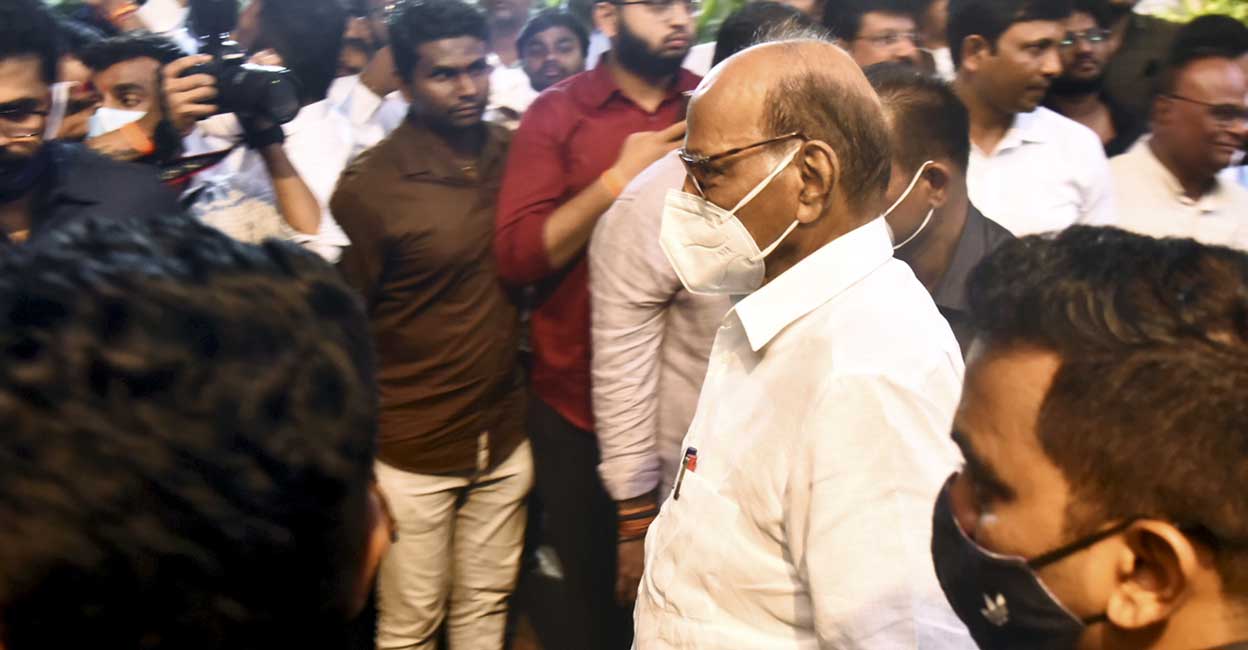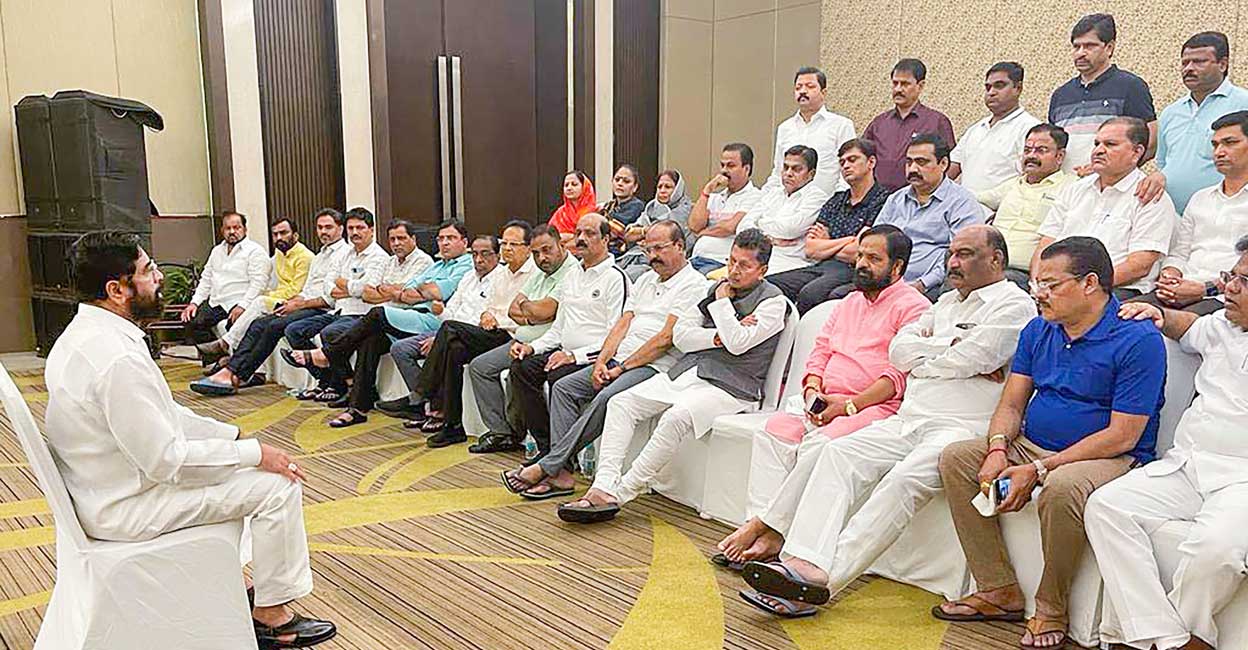Column | Can Pawar, Uddhav steer the MVA alliance, at least, safely?

Mail This Article
The imminent collapse of the Maharashtra Vikas Aghadi (MVA) Government is a painful moment for all the three partners — the Shiv Sena, Nationalist Congress Party and Congress. Interestingly, unlike other coalitions which were targeted by the rampant Bharatiya Janata Party (BJP) under Narendra Modi and Amit Shah, only the Shiv Sena has been hit by 'Operation Lotus' now.
So far the MLAs of the NCP and the Congress, who were seen as more vulnerable, have stood by their party, though Sena rebel Eknath Shinde claims he would have at least 20 NCP and Congress legislators with him after Chief Minister Uddhav Thackeray goes. Shinde is ready to welcome individual MLAs of these two parties though he has accused the NCP and Congress of being against the Hindutva ethos of Shiv Sena. He even charged the NCP for harbouring supporters of fugitive gangster Dawood Ibrahim.
More than the survival of the Maharashtra Government what is paramount is whether the coalition, which was formed two years ago only to prevent the BJP from coming to power, can stay together until the next electoral test, which is the 2024 Lok Sabha election, followed immediately by the Maharashtra assembly elections.
Shiv Sena and NCP leaders have been asserting that three parties would fight the elections together, but if the voices of Uddhav Thackeray and Sharad Pawar in this regard are strong, that of the Congress is much more muted. This is because a dominant group led by Pradesh Congress Committee president Nana Patole feels the Congress has been forced to play second fiddle to NCP in the coalition, and that it should revert to the Congress-NCP alliance in which the Congress was the dominant party.
Warm Pawar, Uddhav ties
Unlike Thackeray and Pawar, who have developed a personal equation, especially after the latter spoiled the efforts of his nephew and Deputy Chief Minister Ajit Pawar to go with the BJP in 2019. Even though Governor Bhagat Singh Koshyari in a hush-hush early morning ceremony had sworn in BJP's Devendra Fadnavis as chief minister and Ajit Pawar as deputy chief minister, the nephew had to yield to the uncle's pressure and leave the BJP company within hours.

The feeling within the Congress is that the party was being treated as a poor cousin, even though it had heavyweights like former chief minister Ashok Chavan, and former PCC president Balasaheb Thorat as ministers. That is because Uddhav, who was new to administration, relied heavily on Sharad Pawar for guidance in dealing with the crises in the state and also face the onslaught of the central government.
Old rivals, new partners
The bonhomie between Shiv Sena and NCP was surprising considering that they were electorally at odds ever since the NCP was formed more than two decades ago. Shiv Sena fought elections in alliance with its long-time partner BJP, while NCP chose to be with the Congress, despite the
fact that NCP leaders had left the Congress protesting Sonia Gandhi's qualification to lead the party due to her foreign origins. The BJP-Shiv Sena combination ruled Maharashtra for two full terms - with a Sena chief minister(s) in first phase, and a BJP chief minister in the second phase. Similarly, the Congress-NCP combination came to power for three consecutive terms, with Congress taking the chief ministerial job every time. Shiv Sena was also part of the BJP-led central governments of Atal Bihari Vajpayee and Modi, while NCP was in the Manmohan Singh government for ten years.
The same pattern in UP, Bihar
However, in many states when two regional parties come together, the relationship becomes rocky soon. In 2015, the Rashtriya Janata Dal (RJD) and Janata Dal (United) came together with the former's ally Congress to fight the BJP, as JD(U) leader Nitish Kumar had left the National Democratic Alliance (NDA) protesting the choice of Modi as the prime ministerial candidate. The coalition, named Mahagathbandhan (Grand Alliance), romped home giving a shock to Modi. Nitish became chief minister, while RJD's Tejashwi Yadav was made deputy chief minister. But the relationship between Nitish and RJD supremo Lalu Yadav was never cordial, and soon Nitish did a reverse turn by abandoning the Grand Alliance and going back to NDA and accepted Modi's leadership. The BJP, which has its own doubts of winning Bihar assembly alone, has accommodated Nitish as chief minister, even though JD(U) got less seats than the BJP in the 2020 state polls.

Similarly in Uttar Pradesh, the two big regional parties — Samajwadi Party of Mulayam Singh Yadav and now his son Akhilesh Yadav and Mayawati's Bahujan Samaj Party — have tried to come together by forgetting their animosities. The two parties first formed an alliance in 1993 in the wake of the Babri Masjid demolition and took on the BJP in the state. With support from the Congress, the SP-BSP alliance came to power and Mulayam was the chief minister. But relations soured in less than two years, and Mayawati withdrew support in June 1995. Angered by her decision, SP workers had attacked her in a government guest house in Lucknow and she had to be escorted by BJP and BSP legislators. Thereafter, Mayawati extended support to the BJP.
After nearly a quarter century, the SP and the BSP came together in 2019 to take on the BJP, saying the guest house incident was a thing of the past, and Akhilesh called Mayawati as his aunt. But the Modi juggernaut crushed the unlikely alliance and now they are daggers drawn at each other.
Equations between regional parties
Regional parties hate each other much more than their animosity towards national parties like the BJP and the Congress. In Andhra Pradesh, it is difficult to imagine YSR Congress and Telugu Desham Party coming together as Chief Minister Y S Jagan Mohan Reddy and his predecessor Chandrababu Naidu intensely dislike each other. Same is the case with the two dominant parties of Tamil Nadu, the DMK and the AIADMK, which however have gone for alliances with the Congress or the BJP, and have taken part in central ministries during the past decades.
In Assam too the Asom Gana Parishad and the Badruddin Ajmal-led All-India United Democratic Front, which are deeply divided over the ethnic, linguistic and religious issues, are unlikely to strike an arrangement as each feeds its voters anger towards the other regional party.
Now it is to be seen how Sharad Pawar and Uddhav Thackeray will shape their immediate political strategies if the Maharashtra Government collapses due to withdrawal of support by Shiv Sena rebels.


